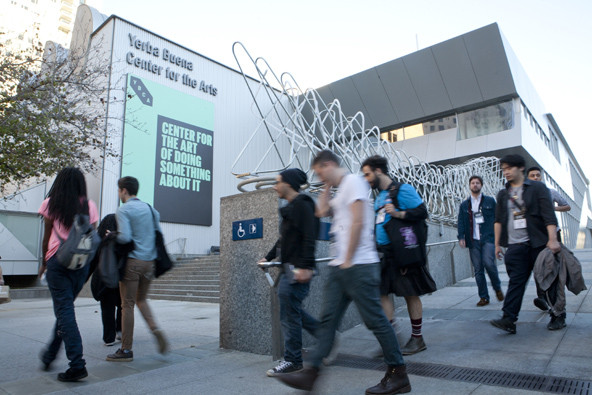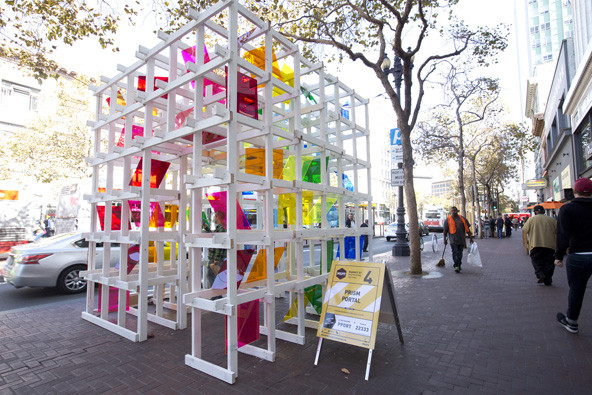At its essence, democracy in the United States is a system of government rooted in a belief in liberty and justice for all. This system depends on the consent and participation of the people. It depends on citizen engagement.
Today, we risk reducing our definition of citizenship to an annual or occasional vote rather than an ongoing, deeply held way of being as a people. In fact, citizenship—including the exercise of voting—is informed and fortified by our participation in public life and our contributions to the public imagination.
I think of public life as the communal demonstration of our collective actions and aspirations, regardless of our age or the papers we hold. It is our participation in street life; in community meetings; at our local schools, community centers, and churches. It is our participation in the shaping of our common culture. This participation is more urgent than ever in light of the proposed 2018 federal budget announced last week, which eliminates every single federal cultural agency, and strikes blows to vital community services for the elderly, children, and the poor.
Our expression of public life is what forms and reforms the infrastructure, systems, institutions, and communities that give our world shape and texture, and that exist to beget the promise of democracy. By participating, we protect and nurture the essential elements of that promise, including freedom of speech, freedom of press, religious liberty, and equal right to vote.
Are you enjoying this article? Read more like this, plus SSIR's full archive of content, when you subscribe.
Indeed, our faltering institutions—of governance, health care, service, finance, and culture—were originally imagined as and made to be the delivery systems for democracy. These institutions are ours to make and remake toward the most perfect version of society that we can imagine together—and today, we must radically reinvent them if we want to make good on the promise of liberty and justice for all.
 Cultural institutions can lead the way in civic engagement. Yerba Buena Center for the Arts. (Photo by Tommy Lau)
Cultural institutions can lead the way in civic engagement. Yerba Buena Center for the Arts. (Photo by Tommy Lau)
Yet, as a people we are deeply fractured and many of us are living in fear of what is to come. To be afraid and intractably apart is to be immobilized somewhere between helplessness and hopelessness. And without hope, we are devoid of public imagination—the communal expression that allows us to lift up and out of our own particular circumstances to reach for a better tomorrow.
I believe this radical reinvention of our institutions is the necessary and defining work of the remainder of this century, and our cultural institutions must lead the way. Arts and culture organizations of all shapes and sizes across the United States were created to nurture creativity and imagination, and remind us of our potential as human beings. And as such, these organizations have the power to drive the cultural movement we need to make remake the systems that deliver our democracy—to drive a shift in the values, stories, and traditions to which we hold our institutions and ourselves accountable.
To do this, arts and culture organizations must understand themselves not as arbiters of taste, but as creative homes for the people. They must be places driven by artists, culture bearers, philosophers, and activists. They must be platforms for cultivating public imagination; building thick and diverse networks; convening across differences and sectors; and incubating breakthrough ideas that stick, because they spring from communities that come together to embrace truth, honor diversity, and poetically pursue freedom.
Over the past several years—believing that culture precedes policy and cultural movement catalyzes lasting change—our organization, Yerba Buena Center for the Arts (YBCA), has worked to redefine the role of the contemporary arts center in today’s society. Rather than defining ourselves only by the distinct artistic disciplines in which we work (visual and performing arts, film, and arts-driven civic engagement), we are also defining ourselves—by way of these disciplines—as a culture catalyst. Each year we invite artists, scientists, athletes, teachers, activists, and other creative change-makers who are shaping culture to an event called the YBCA 100 Summit. There, they share the questions driving their work—urgent questions about culture, politics, art, technology, and belonging. Attendees are active participants, responding to these questions and working together to push them in new directions. In turn, YBCA uses all the dialogue and creative output from the summit to develop three big questions that guide our own work as an institution. Recent summits have resulted in questions like: Can we design freedom? What does equity look like? Why citizenship?
From there, we pursue these questions through five interlocking platforms:
- The making and sharing of leading edge contemporary art
- The incubation of game changing creative ideas
- A commitment to inquiry, and asking the urgent questions of our time
- Convening that bridge people, communities, and sectors
- Civic coalitions that create lasting change and policy shift
These platforms allow us to put equal emphasis on visual art, performing arts, the art of film, and art-driven civic engagement—all of which drive cultural movement. A few examples:
- A recent question from the summit (who gets to design the future of urban life?) resulted in a groundbreaking partnership with the San Francisco Planning Department that produced the Market Street Prototyping Festival and has permanently shifted the culture of planning in our city.
- In response to questions around freedom of expression and citizenship, we recently hosted an over-sold convening in collaboration with the ACLU of Northern California.
- An exhibition in our galleries by Teddy Cruz and Fonna Foreman explores questions about borders and imagination by examining three models of civic leadership that simultaneously focus on cultural and political shift to achieve lasting urban transformation.
- Not long ago, we announced a pay-what-you-can membership to assure that the ability to pay is never a barrier for people to participate in cultural movement.
 Who gets to design the future of urban life? Prism Portal prototype, 2016 Market St. Prototyping Festival. (Photo by Tommy Lau)
Who gets to design the future of urban life? Prism Portal prototype, 2016 Market St. Prototyping Festival. (Photo by Tommy Lau)
Other organizations are also exploring new civic engagement territory. Santa Cruz Museum of Art and History's Executive Director, Nina Simon, recently published a book called the Art of Relevance, which skillfully examines the role of museums as catalysts and connectors in their communities. Springboard for the Arts in St. Paul, an economic and community development organization that connects artists and communities, has a Creative Exchange project that offers practical, open-source, artist-created toolkits to spark change and inspire connection. And the Mississippi Cultural Production Center is facilitating a multi-media archival process connecting younger generations with historic economic strategies rooted in land cultivation and agricultural production. This inventive process will result in a permanent economic hub for arts and agricultural production in rural Utica, Mississippi.
Great and abiding societal movements are the result of cultural shift—a progression of shared values, beliefs, and convictions that successfully and forever change hearts and minds. Evolution in areas like civil rights, equal rights, reproductive rights, marriage equality, or environmental justice could not have been achieved through transaction (litigation, legislation) alone.
With all of these advancements, there came a moment when the majority of people believed that existing institutions—those delivery systems of democracy—needed to better serve humanity. Artists, community leaders, and activists ignited the public imagination and helped us see ourselves forward. While many of these evolutions may be under threat right now, cultural movement has historically changed hearts and minds, and those advances are not easily overturned.
The raw material of our democracy is individual creativity and collective imagination. At a time of immense atomization, we need to shift the culture of our nation back and toward its basic ideals—and our cultural institutions must lead the way.
Support SSIR’s coverage of cross-sector solutions to global challenges.
Help us further the reach of innovative ideas. Donate today.
Read more stories by Deborah Cullinan.

